I have a df attached and I would like to create a loop that would apply a specific sequence (set by the user in R) based on conditions in column "x9". I would like to be able to set the sequence myself so I can try different sequences for this data frame, I will explain more below.
I have a df of losses and wins for an algorithm. On the first instance of a win I want to take the value in "x9" and divide it by the sequence value. I want to keep iterating through the sequence values until a loss is achieved. Once a loss is achieved the sequence will restart, when "x9" <0 to be specific.
I would like to create the two columns in my example "Risk Control" and "Sequence". Ideally I would like the function to iterate through the entire data frame so I can compare the column "x9" to "Risk Control".
Sample Data:
structure(list(x1 = c(1, 2, 3, 4, 5, 6, 7, 8, 9, 10), x2 = c("2016.01.04 01:05",
"2016.01.04 01:12", "2016.01.04 01:13", "2016.01.04 01:17", "2016.01.04 01:20",
"2016.01.04 01:23", "2016.01.04 01:25", "2016.01.04 01:30", "2016.01.04 01:31",
"2016.01.04 01:59"), x3 = c("buy", "close", "buy", "close", "buy",
"close", "buy", "t/p", "buy", "close"), x4 = c(1, 1, 2, 2, 3,
3, 4, 4, 5, 5), x5 = c(8.46, 8.46, 8.6, 8.6, 8.69, 8.69, 8.83,
8.83, 9, 9), x6 = c(1.58873, 1.58955, 1.5887, 1.58924, 1.58862,
1.58946, 1.58802, 1.58902, 1.58822, 1.58899), x7 = c(1.57873,
1.57873, 1.5787, 1.5787, 1.57862, 1.57862, 1.57802, 1.57802,
1.57822, 1.57822), x8 = c(1.58973, 1.58973, 1.5897, 1.5897, 1.58962,
1.58962, 1.58902, 1.58902, 1.58922, 1.58922), x9 = c(0, 478.69,
0, 320.45, 0, 503.7, 0, 609.3, 0, 478.19), x10 = c(30000, 30478.69,
30478.69, 30799.14, 30799.14, 31302.84, 31302.84, 31912.14, 31912.14,
32390.33), `Risk Control` = c(NA, 478.69, NA, 320.45, NA, 251.85,
NA, 304.65, NA, 159.3966667), ...12 = c(NA, NA, NA, NA, NA, NA,
NA, NA, NA, NA), Sequence = c(NA, 1, NA, 1, NA, 2, NA, 2, NA,
3)), row.names = c(NA, -10L), class = c("tbl_df", "tbl", "data.frame"
), spec = structure(list(cols = list(x1 = structure(list(), class = c("collector_double",
"collector")), x2 = structure(list(), class = c("collector_character",
"collector")), x3 = structure(list(), class = c("collector_character",
"collector")), x4 = structure(list(), class = c("collector_double",
"collector")), x5 = structure(list(), class = c("collector_double",
"collector")), x6 = structure(list(), class = c("collector_double",
"collector")), x7 = structure(list(), class = c("collector_double",
"collector")), x8 = structure(list(), class = c("collector_double",
"collector")), x9 = structure(list(), class = c("collector_double",
"collector")), x10 = structure(list(), class = c("collector_double",
"collector")), `Risk Control` = structure(list(), class = c("collector_double",
"collector")), ...12 = structure(list(), class = c("collector_logical",
"collector")), Sequence = structure(list(), class = c("collector_double",
"collector"))), default = structure(list(), class = c("collector_guess",
"collector")), delim = ","), class = "col_spec"))
In short I need assistance in:
1.Constructing a sequence to apply to my df, would like to be able to alter this sequence to try different sequences;
2.Take values in "x9" and create a new column that would apply the sequence values set. The sequence is taking the value in "x9" and dividing it by the sequence number
3.Construct a loop to iterate through the entire df to apply this over all of the values of the dataframe.
In the example above I have manually created "Risk Control" and the sample "Sequence". The sequence in the example is 1,1,2,2,3,3,4. The sequence in the sample uses each number twice before iterating to the next number. Once a loss is achieved in "x9" the sequence restarts.
I would appreciate any help with this function and loop. Thank you
